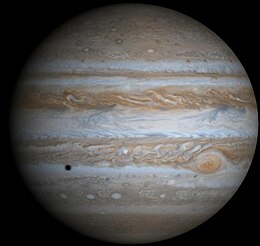This article is about the planet. For other uses, see Jupiter (disambiguation).

A composite Cassini image of Jupiter. The dark spot is the shadow of Europa. The Great Red Spot, a persistent anticyclonic storm, is at lower right. White atmospheric bands, termed zones, represent areas of upwelling; brown bands, called belts, represent areas of downwelling. They display high-altitude ammonia ice clouds and lower clouds of unknown composition, respectively.
|
||||||||||||||||||
| Designations | ||||||||||||||||||
|---|---|---|---|---|---|---|---|---|---|---|---|---|---|---|---|---|---|---|
| Pronunciation | ||||||||||||||||||
| Adjective | Jovian | |||||||||||||||||
| Orbital characteristics[5][a] | ||||||||||||||||||
| Epoch J2000 | ||||||||||||||||||
| Aphelion | 816,520,800 km (5.458104 AU) | |||||||||||||||||
| Perihelion | 740,573,600 km (4.950429 AU) | |||||||||||||||||
| Semi-major axis | 778,547,200 km (5.204267 AU) | |||||||||||||||||
| Eccentricity | 0.048775 | |||||||||||||||||
| Orbital period |
|
|||||||||||||||||
| Synodic period | 398.88 days[3] | |||||||||||||||||
| Average orbital speed | 13.07 km/s[3] | |||||||||||||||||
| Mean anomaly | 18.818° | |||||||||||||||||
| Inclination |
|
|||||||||||||||||
| Longitude of ascending node | 100.492° | |||||||||||||||||
| Argument of perihelion | 275.066° | |||||||||||||||||
| Satellites | 67[3] | |||||||||||||||||
| Physical characteristics | ||||||||||||||||||
| Mean radius | 69,911 ± 6 km[6][b] | |||||||||||||||||
| Equatorial radius | ||||||||||||||||||
| Polar radius | ||||||||||||||||||
| Flattening | 0.06487 ± 0.00015 | |||||||||||||||||
| Surface area | ||||||||||||||||||
| Volume | ||||||||||||||||||
| Mass | ||||||||||||||||||
| Mean density | 1.326 g/cm3[3][b] | |||||||||||||||||
| Equatorial surface gravity | 24.79 m/s2[3][b] 2.528 g |
|||||||||||||||||
| Escape velocity | 59.5 km/s[3][b] | |||||||||||||||||
| Sidereal rotation period | 9.925 h[9] (9 h 55 m 30 s) | |||||||||||||||||
| Equatorial rotation velocity | 12.6 km/s 45,300 km/h |
|||||||||||||||||
| Axial tilt | 3.13°[3] | |||||||||||||||||
| North pole right ascension | 268.057° 17 h 52 min 14 s[6] |
|||||||||||||||||
| North pole declination | 64.496°[6] | |||||||||||||||||
| Albedo |
0.343 (Bond) 0.52 (geom.)[3] |
|||||||||||||||||
|
||||||||||||||||||
| Apparent magnitude | -1.6 to -2.94[3] | |||||||||||||||||
| Angular diameter | 29.8" – 50.1"[3] | |||||||||||||||||
| Atmosphere[3] | ||||||||||||||||||
| Surface pressure | 20–200 kPa[10] (cloud layer) | |||||||||||||||||
| Scale height | 27 km | |||||||||||||||||
| Composition |
|
|||||||||||||||||
Jupiter is primarily composed of hydrogen with a quarter of its mass being helium, although helium only comprises about a tenth of the number of molecules. It may also have a rocky core of heavier elements,[15] but like the other gas giants, Jupiter lacks a well-defined solid surface. Because of its rapid rotation, the planet's shape is that of an oblate spheroid (it possesses a slight but noticeable bulge around the equator). The outer atmosphere is visibly segregated into several bands at different latitudes, resulting in turbulence and storms along their interacting boundaries. A prominent result is the Great Red Spot, a giant storm that is known to have existed since at least the 17th century when it was first seen by telescope. Surrounding Jupiter is a faint planetary ring system and a powerful magnetosphere. There are also at least 67 moons, including the four large moons called the Galilean moons that were first discovered by Galileo Galilei in 1610. Ganymede, the largest of these moons, has a diameter greater than that of the planet Mercury.
Jupiter has been explored on several occasions by robotic spacecraft, most notably during the early Pioneer and Voyager flyby missions and later by the Galileo orbiter. The most recent probe to visit Jupiter was the Pluto-bound New Horizons spacecraft in late February 2007. The probe used the gravity from Jupiter to increase its speed. Future targets for exploration in the Jovian system include the possible ice-covered liquid ocean on the moon Europa.
No comments:
Post a Comment